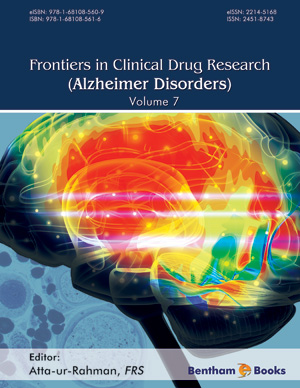Abstract
Alzheimer’s disease (AD) is a progressive and an irreversible chronic neurodegenerative disorder causing dementia. Worldwide, the prevalence of AD is estimated to be 30 million and likely to quadruple in the next 40 years. Thus, the global cost of dementia is estimated to be 1.09% of global GDP (US$ 818 billion). Several factors including age and family history are involved in its etiology and considered as the predisposing factors for AD. The neurochemical basis of AD can be explained by the ‘Cholinergic’, ‘Amyloid plaque’ and ‘Tauopathy’ hypotheses. The ‘Cholinergic’ hypothesis put forth a relationship between Acetyl choline (ACh) levels to cognitive memory and the other two hypotheses propose an excessive deposition of amyloid plaques extracellularly and accumulation of tau protein intracellularly, eventually causing neuronal death. The cholinergic system is mainly targeted for therapeutic management of AD symptoms. In view of that, acetylcholinesterase inhibitors (AChEI) such as tacrine, donepezil, rivastigmine and galantamine have been used. Memantine, an N –methyl – D - aspartate (NMDA) receptor antagonist inhibiting glutamate mediated exocitotoxicity, is also used to improve dementia symptoms. However, the degree of improvement with this approach has been minimal as no one of these drugs can reverse the course of AD, nor prevent destruction of neurons. Accordingly, amyloid based strategies including ‘secretive enzymes modulation’, ‘amyloid aggregation prevention’ and ‘amyloid clearance promotion’ have been adopted. Inhibition of tau phosphorylation/oligomerization, microtubule stabilization, reduction of stress/inflammation, modulation of neurotransmitters and cellular calcium homeostasis has also been used as strategy to manage AD with varying degree of success. A high rate of attrition combined with huge cost of new drug development has encouraged drug repurposing strategies. This approach ensures minimal developmental cost and shorter approval time to launch a drug. Moreover, the risk associated with conventional drug discovery is reduced due to existing pharmacokinetic and safety data. Thus, drug repurposing is considered to be a preferred strategy against AD. Modern advances in disease biology of AD have substantially assembled data from pre-clinical, clinical, in-vitro, epidemiological, toxicological, and computational sources. Thus, an implementation of systematic approaches using this on hand information with a clear understanding of the network pharmacology can give way the next therapeutic alternative for successful management of AD. The current chapter describes the scope and limitations of some currently marketed drugs like cholinergic drugs, cyclooxygenase (COX) and lipoxygenase (LOX) inhibitors, renin angiotensin system (RAS) inhibitors, lipid lowering drugs (statins), NMDA receptor antagonists, anti-diabetics, anti-oxidants, vitamin D etc in management of AD. Many of them have the potential against AD and some of them are validated pre-clinically and clinically. But none of them has reached the market yet. Drugs targeting neuroinflammation including COX inhibitors, LOX inhibitors and RAS inhibitors can potentially arrest the disease progression in AD. However, their repurposing potential needs to be clinically validated.






















